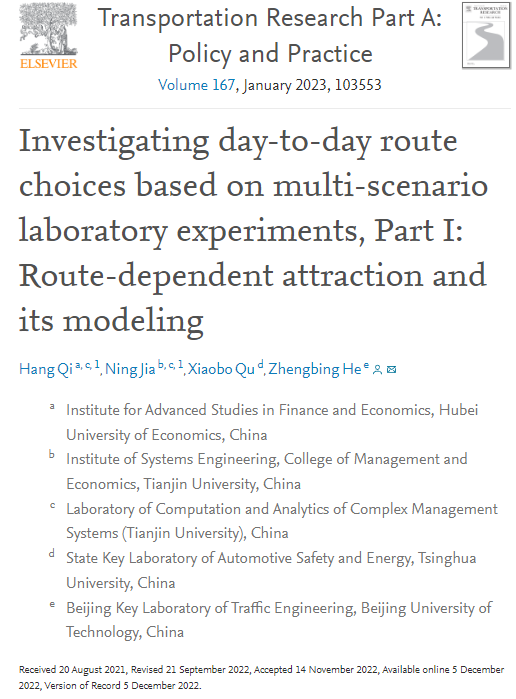近日,我院齐航副教授以第一作者身份、以湖北经济学院为第一署名单位,与天津大学贾宁教授、清华大学曲小波教授、北京工业大学贺正冰教授合作的论文《Investigating day-to-day route choices based on multi-scenario laboratory experiments. Part I: route-dependent attraction and its modeling》被运输经济学国际顶尖刊物《Transportation Research Part A: Policy and Practice》接受发表。齐航博士始终从事城市交通管理与实验经济学交叉方向的研究,其博士论文获得天津市优秀博士学位论文荣誉。这篇论文的研究内容是其博士论文的后续成果之一,受到国家自然科学基金等项目资助。
《Transportation Research Part A: Policy and Practice》是交通研究领域的国际顶级期刊,SSCI与SCI双收录,JCR-Q1, 中科院二区,影响因子6.615。系ABS(英国商学院协会)3星期刊,ABDC(澳大利亚商学院院长理事会)4星期刊。
摘要:
In the area of urban transportation networks, a growing number of day-to-day (DTD) traffic dynamic theories have been proposed to describe the network flow evolution, and an increasing amount of laboratory experiments have been conducted to observe travelers’ behavior regularities. However, communication between theorists and experimentalists has not been made. This paper devotes to 1) detecting unanticipated behavior regularities by conducting a series of laboratory experiments, and 2) improving existing DTD dynamics theories by embedding the observed behavior regularities into a route choice model. First, 312 subjects participated in one of the eight decision-making scenarios and make route choices repeatedly in congestible parallel-route networks. Second, three route-switching behavior patterns that cannot be fully explained by the classic route-choice models are observed. Third, to enrich the explanation power of a discrete route-choice model, behavioral assumptions of route-dependent attractions, i.e., route-dependent inertia and preference, are introduced. An analytical DTD dynamic model is accordingly proposed and proven to steadily converge to a unique equilibrium state. Finally, the proposed DTD model could satisfactorily reproduce the observations in various datasets. The research results can help transportation science theorists to make the best use of laboratory experimentation and to build network equilibrium or DTD dynamic models that embrace both real behavioral basis and beautiful mathematical properties.

